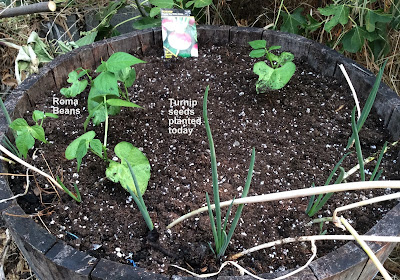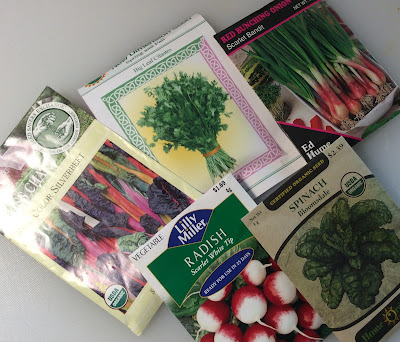 |
| Barrel #1. Asian Greens, Kohlrabi, Bunching Onions. 8.26.15 |
This is a progress report on some of the seeds I am starting for later Summer, or early Fall starts, for Fall and early winter benefit. These are all barrel planters that I either had with something earlier that finished, or had left alone for a year or two and now being called back into service. If there were weeds, I pulled out the weed plants - easy with soft potting soil, then turned the top layer of soil with a hand-spade, and added a top layer of a few inches of potting soil. The one with the dead bamboo, was too root bound, so I just added some potting soil on top.
 |
| Barrel #3. Chinese pole beans and last year's garlic. 8.26.15 |
 |
| Barrel #4. Roma beans, Turnips, and a few E.W.O. Scallions. 8.26.15 |
I want the beans mostly for seeds. Seeds take longer than fresh beans, but nothing ventured, nothing gained.
This year is projected for a warmer winter due to the impending el Niño effect. I speculate that will extend the season. If not, that's OK too.
Days currently in 90s. Nights in 50s and 60s. Seeds are germinating quickly. The barrels need daily water. The plants are concentrated in small spaces, so shade the soil and not needing as much care as if in the ground. I am watering with 1/4 tsp miracle grow in 2 gallons of water. Basically fertigating. For some, I occasionally peecycle with 1/2 liter of home-grown fertilizer in 2 gallons. Not more, because I don't want salt build up.
I'm getting excellent, rapid growth for
Egyptian walking onions,
nasturtiums, and
Swiss chard. Should have some for cooking in 2 or 3 weeks.
Spinach might also be ready in 3 or 4 weeks. The nasturtiums are for adding leaves too salads. The E.W. onions are for scallions, and to maintain my crop. I got about 80% viable from the ones that were in the bed I wanted to renovate, chewed off by rabbits or deer, crowded by wild carrot, and left dry. E.W. Onions are a damn hardy breed.
As I dig more into the old E.W. bed that I want to renovate, I remove more, clean them up, and plant them in random spots among other plants. That will give a more extended Fall harvest of scallions, and also some to leave through the winter for Spring harvest and to maintain the clone.

|
| Barrel #6. Nasturtiums, Spinach, and some E.W.O. Scallions. 8.26.15 |
Today I planted seeds for
Kohlrabi - expect harvest in 60 days, and
Turnip - expect harvest in 50 days. With the hot summer weather, they should get a fast start, then slow down a little as it cools.
 |
| Barrel #7. Egyptian Walking Onions. ~3 Weeks, 8.26.15 |
 |
| Some of the seeds I am starting. 8.26.15 |
I also planted an Asian Greens mix that contains equal parts
Arugula,
Chinese cabbage,
Japanese spinach,
mustard-mizuna,
mustard-green,
mustard-Ruby Streaks, and
tatsoi. Those were planted about one week ago and now are all germinated.
Cilantro seeds are also included in the barrel gardens, and growing. The goal with those is to plant a few more each week, for extended harvests.
I planted
scarlet bunching onion seeds because I saw them in the store and wanted to try something different. At the time I didn't know if the E.W. onions would grow. The scarlet bunching onion seeds are also germinating.
All in all, I think the late summer planting in large containers, has a lot of potential for kitchen gardening. Easy, more accessible for the older or less vigorous gardeners, and grow more in a very compact space. Not much bending over at all, very easy to pull out tiny weeds and putter.















